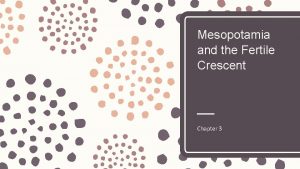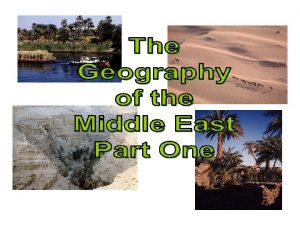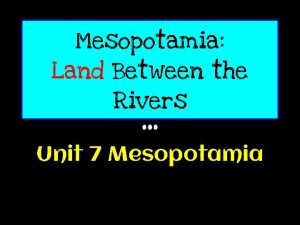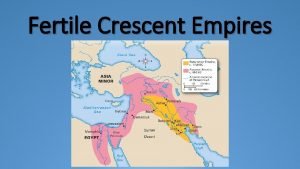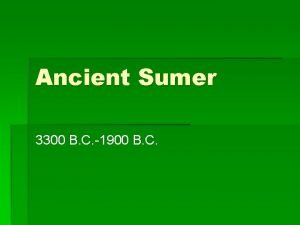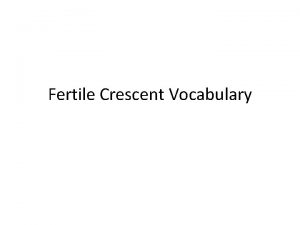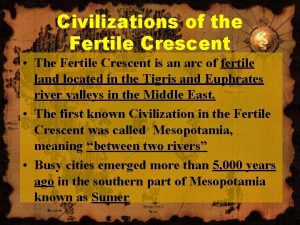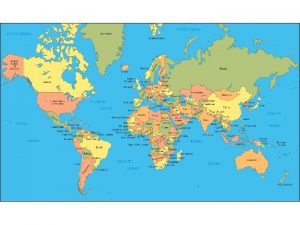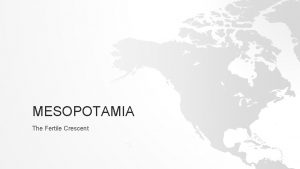Water Crisis in Iraq The Fertile Crescent 4000








- Slides: 8

Water Crisis in Iraq The Fertile Crescent 4000 Years after the Birth of Civilization The Earth is called the “blue planet” because of its extensive reserves of water. However, 98% of this water is not fresh water. Even though three-fourths of the earth's surface is covered by water, it is mainly salt water from the ocean. The remaining 2% accounts for the fresh water supplies, but 90% of this water is either in the poles or remains under the ground. In reality, humans actually have access to only. 000006% of the water available on our planet. As fresh water resources they make up only. 26% of the water that is available to human consumption. The importance of scarce fresh water is yet to be understood by many people and nations, despite the fact that most of the developing nations are located in the arid or semi-arid regions of the world, where water is the most scarce. For example, Europe contains the half of the running surface water in the world alone. At the same time in the Middle East, water scarcity is so severe that nations are threatening each other with war. In 88 developing countries, with nearly 40 per cent of world's population, water shortages are already a serious constraint on their development. Besides Turkey, Syria, and Iraq, who share the Euphrates-Tigris water basin, almost all of the nations in the Middle East suffer from serious water scarcity. And yet, the Euphrates-Tigris flood plains are often called the “cradle of civilization. ” How can a region that saw the rise of the first human civilizations because of its water supply and unique geographical features be in a state of crisis?

Introduction: The Geography of the Tigris and Euphrates Rivers The area that was ancient Mesopotamia is primarily the modern country of Iraq. The geography and climate of Iraq has greatly impacted the country’s inhabitants and way of life. Iraq is mostly desert, with cool winters and hot, dry, cloudless summers. With the exception of the northern mountainous regions along the Iranian and Turkish borders, the country is mostly broad plains. Only about 13% of the land is farmable, with this land being primarily along the flood plains of the Euphrates and Tigris Rivers. Population is concentrated were there are supplies of fresh water—be they underground or above ground sources. The Euphrates River, the longest river in Southwestern Asia, runs through three different countries in the Middle East region. It originates in the eastern highlands of the modern country of Turkey. Two major tributaries, the Murat and the Karasu, feed the river. Both rivers are located in Turkey. These two rivers come together around the Turkish city of Elazig. The Euphrates River then continues southeast in the country of Syria where it is joined by two additional tributaries—the Khabur and the Balikh. These two tributaries have their sources in Turkey. They are the last bodies of water to feed the Euphrates River. The Euphrates River then continues on a southeast course into Iraq where it will eventually open into the Persian Gulf. Once river reaches the city of Hit, the river is only at 53 meters above sea level. From this point downstream the river begins to lose a considerable amount of water. First, the river is a source of fresh water for a series of irrigation canals. Second, the river feeds Lake Hammar. The Euphrates River is joined by the Tigris River near the city of Qurna. When the two rivers join together, they are referred to as Shatt al-Arab. Two additional tributaries join the Shatt at Basra, and then they empty into the Persian Gulf altogether. The Tigris River, the second largest river in Southwest Asia, also has its origins in the highlands of eastern Turkey. However, the water sources for the river come from the tributaries in Iraq. There are four tributaries—the Greater Zap, the Lesser Zap, the Adhaim, and the Diyala. Because these tributaries are fed by the melting snows of the Zargos Mountains and seasonal rainfall, the Tigris River carries more water than the Euphrates River. However, extensive irrigation and canal systems remove about 70 -80% of its waters before merging with the Euphrates near the city of Qurna to form the Shatt al-Arab. The capital city of Iraq, Baghdad, is located on the conjunction of the Tigris and Diyala Rivers. Navigation of the river is possible from Baghdad downstream. Most of the Tigris River north of Baghdad is not navigable. Since antiquity, the river has been infamous for its irregular flooding, which is caused by the irregular flows of its four tributaries. To control these floods, the Iraqis divert water from the Tigris to the Euphrates, where the Euphrates has less alleviation than the Tigris.

Problem 1: International Water Rights The most frequently cited culprits are the Turkish and Syrian governments. Iraq has plenty of water, but it is a downstream country. There at least seven dams on the Euphrates in Turkey and Syria, according to Iraqi water officials, and with no treaties or agreements, the Iraqi government is reduced to begging its neighbors for water. In 2009, the Water Ministry announced that Turkey had doubled the water flow into the Euphrates, salvaging the planting phase of the rice season in some areas. That move increased water flow to about 60 percent of its average, just enough to cover half of the irrigation requirements for the summer rice season. Though Turkey has agreed to keep this up and even increase it, there is no commitment binding the country to do so. With the Euphrates showing few signs of improvement, bitterness over Iraq’s water threatens to be a source of tension for months or even years to come between Iraq and its neighbors. Many American, Turkish and even Iraqi officials, disregarding the accusations as election-year posturing, say the real problem lies in Iraq’s own deplorable water management policies. Along the river, there is no shortage of resentment at the Turks and Syrians. But there is also resentment at the Americans, Kurds, Iranians and the Iraqi government, all of whom are blamed. Scarcity makes foes of everyone.

Problem 2: The Iraqi Karez are subterranean aqueducts and historically have played a vital role in development of the economies and cultures of villages throughout Iraq. They are engineered to collect groundwater and redirect it, through a subsurface tunnel with a gradual slope, to surface canals that provide water to settlements and agricultural fields. Some karez tap into renewable water sources (rainwater collected over time through layers of soil). Others tap deep into nonrenewable water sources. As renewable water sources continue to yield less and less water each year, old wells are abandoned and new ones are built, tapping into the nonrenewable underground water sources. However, in order to retrieve water from the nonrenewable sources, a karez needs to be drilled deep into the ground. As a nonrenewable water source dries up, the water become more salty. As it retains natural salts found in deep layers of soil. In addition, poor maintenance of karez because of lack of money and labor, have also contributed to the wasteful evaporation of precious fresh water.

Problem 3: Droughts and Poor Harvests Devastating drought gripped Iraq in the 2007 -2008 growing season. The drought continued into 2009. Because of below-average rainfall, insufficient water in the Euphrates and Tigris Rivers, and years of misuse by Iraq and its farmers, the Euphrates River is significantly smaller than it was a decade ago. Drought-affected area stretched in an arc from northern Syria to southern Iran. The most affected area was in northern Iraq, the country’s historical breadbasket, where rain-fed wheat is grown. The winter wheat crop depends on the rain that falls between October and April. Since the crop has little access to other sources of water, the poor vegetation conditions are a direct response to the lack of rainfall at the end of the critical rainfall period. Winter grain crops account for more than 85 percent of Iraq’s total grain production. From 2007 -2010, the winter wheat harvest was well below normal. But prolonged drought doesn’t just reduce crop production. It increases fire hazards, livestock and wildlife death rates, and damage to wildlife and fish habitat. Drought is also associated with increases in insect infestations, plant disease, and wind erosion. This is a crisis that threatens the roots of Iraq’s identity, not only as the land between two rivers but as a nation that was once the largest exporter of dates in the world, that once supplied German beer with barley and that takes patriotic pride in its expensive Anbar rice. Now Iraq is importing more and more grain. Farmers along the Euphrates say, with anger and despair, that they may have to abandon Anbar rice for cheaper varieties. Droughts are not rare in Iraq, though officials say they have been more frequent in recent years. Saman, Moises. 13 July 2009. New York Times. Web. 23 Sept. 2011. <http: //www. nytimes. com>.

Problem 4: Waste of Resource, Resource Full of Waste International offices have stated that nothing will improve in Iraq if its leaders do not seriously address its own water policies and its history of flawed water management. Leaky canals and wasteful irrigation practices squandered the water, and poor drainage left fields so salty from evaporated water nothing can growth there anymore. Now women and children dredge huge white mounds of salt from sitting pools of runoff. On a scorching morning in Diwaniya, Bashia Mohammed, 60, works in a drainage pool by the highway Saman, Moises. 13 July 2009. New York Times. Web. 23 Sept. 2011. <http: //www. nytimes. com>. gathering salt, her family’s only source of income now that its rice farm has dried up. But the dead farm is not the real crisis. “There’s no water in the river that we drink from, ” she said, referring to a channel that flows from the Euphrates. “It’s now totally dry, and it contains sewage water. They dig wells but sometimes the water just cuts out and we have to drink from the river. All my kids are sick because of the water. ” During both US wars in Iraq, the targeting of sewage and water treatment plants contributed to the mass contamination of the Trigris River, and triggered many waterborne diseases. In 2003 a cholera epidemic broke out in Iraq and claimed thousands of lives. In addition to pollution from sewage, chemicals used during the war effort have also begun to contaminate the water supply. Children in certain regions are being born with serious birth defects. Here, Iraqi children navigate sewage and mud after filling a bucket of water from a public water source in Baghdad's eastern suburb of Fadaliayah, Iraq, on Thursday, Sept. 22, 2011. The neighborhood has no municipal water supply. Kadim, Karim. . Associated Press Images. 22 Sept 2011. Web. 23 Sept 2011. <http: //apimages. ap. org. >.

Problem 5: Desertification Abduredha Joda stands on a dry plot of land where he lives with his family on the outskirts of Karbala. This area was filled with water from a lake that now is dry. Mr. Joda, a native of Basra, came to Karbala in 2004 to fish and raise water buffaloes in the lush wetlands that reminded him of his home. “There used to be water everywhere, ” said Abduredha Joda, 40, sitting in his reed hut on a dry, rocky plot of land outside Karbala. Mr. Joda, who describes his dire circumstances with a tired smile, grew up near Basra but fled to Baghdad when Saddam Hussein drained the great marshes of southern Iraq in retaliation for the 1991 Shiite uprising. He came to Karbala in 2004 to fish and raise water buffaloes in the lush wetlands there that remind him of his home. “This year it’s just a desert, ” he said. Iraq is far from the only country affected by desertification, but its tumultuous history has made it particularly vulnerable. “Iraq has fought many wars, ” noted Mohammed Ghazi Saeed, head of the national agriculture ministry’s anti-desertification department. “They have greatly damaged the country’s environment. ” Saeed said the situation worsened notably after now-executed dictator Saddam Hussein’s 1990 invasion of Kuwait, and the subsequent international coalition that formed to evict him from the neighbouring emirate. As Saddam’s forces fled Kuwait, they burned oil wells there, which Saeed said left Iraq “black, literally. ” “Of course, this poisoned the soil, the water, and led to the disappearance of many plant areas. ” The dictator’s military vehicles also destroyed green areas in the south and centre of Iraq by loosening the soil as they traversed them, and his forces chopped or burned down swathes of vegetation as part of efforts to track down internal dissidents. This has combined with climate change — Iraq has suffered several droughts over the past decade — to worsen an already difficult environmental situation, with sandstorms in Baghdad regularly forcing the closure of the capital’s airport, and leading to increased hospital visits due to respiratory problems. He also admitted that while authorities across Iraq were working Saman, Moises. 13 July 2009. New York Times. Web. 23 Sept. 2011. <http: //www. nytimes. com>. to combat desertification, he was still not confident they would see the plans through to their conclusion. _____. “Iraq 'green belt' front line in anti-desertification fight. ” 11 June 2012. Times Live. Web “It is not really difficult to plant a tree — what is important is to Sept 21. 2012. <http: //www. timeslive. co. za/scitech/article 5326756. ece>. let it grow, ” he said. “I must admit that the government is not yet fully capable, it is still weak in terms of completing projects. ” Har was even harsher in his assessment of how much more needed to be done. “I think Iraq is really far behind when it comes to the fight against desertification, and it really does not have strong measures to push efficient water usage, ” he said. “Even today, we do not consider it an essential part of life, and we waste water. ” Alluding to the years of violence that racked Iraq from 2006 to 2008, when confessional violence left tens of thousands dead, Har added: “Sandstorms now pose more of a problem than explosions. ”

Problem 6: Where’s the Water During the drought crisis of 2009, water levels dropped, measured in feet. Bridges show evidence of the declining water levels. Here an Iraqi fisherman navigates his boat in the once deep and now shallow waters of the Euphrates under the Hindiyah Bridge. Drought is not the only reason for the decline in fresh water. The 1991 Gulf War brought on a water crisis in Iraq. During the offensive, US military bombed water treatment facilities, which triggered serious water shortages throughout the country. Out of the seven major water pumping stations, four were destroyed. Then, in 2003 the US invaded Iraq. Once again the US targeted civilian infrastructure, and left many southern Iraqis with little or no access to water in the first weeks of the occupation. This water crisis has continued and grown in the years following the initial invasion. Here, Iraqi women wait for incoming water supplies while confronted by British troops. Troops often distributed bottle watered, but often had to quell skirmishes as desperate peoples fought to receive limited rations. Saman, Moises. 13 July 2009. New York Times. Web. 23 Sept. 2011. <http: //www. nytimes. com>. _____. Water Wars and International Conflict. Water Is Life. Web. 23 Sept. 2011. <http: //academic. evergreen. edu/g/grossmaz/OFORIAA/>.
